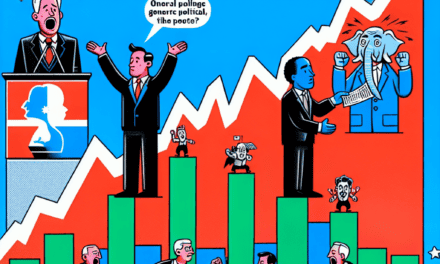“Trump’s Win Boosts Stocks, But Market Clouds Loom Ahead”
Introduction
Following Donald Trump’s unexpected victory in the 2016 U.S. presidential election, stock markets experienced a significant surge, driven by investor optimism about potential pro-business policies, tax cuts, and deregulation. However, this post-election rally may face challenges in sustaining its momentum. Concerns are emerging about the feasibility and timing of implementing Trump’s economic agenda, potential geopolitical tensions, and the Federal Reserve’s monetary policy adjustments. Additionally, market valuations have reached elevated levels, prompting caution among investors about the possibility of a market correction. As these factors converge, the initial euphoria may give way to a more tempered market outlook.
Historical Market Reactions to Political Events
The relationship between political events and stock market reactions has long been a subject of interest for economists, investors, and policymakers alike. Historically, markets have demonstrated a tendency to react to political developments, often with significant volatility. The election of Donald Trump in 2016 serves as a prime example of this phenomenon. Following his unexpected victory, the stock market experienced a notable surge, with the Dow Jones Industrial Average climbing to unprecedented heights. This rally was largely driven by investor optimism surrounding Trump’s pro-business policies, including tax cuts and deregulation. However, while the initial market response was overwhelmingly positive, historical patterns suggest that such rallies may not be sustainable in the long term.
To understand why the post-election rally might be short-lived, it is essential to examine past instances where political events have influenced market behavior. For instance, the election of Ronald Reagan in 1980 also led to a significant market upswing, fueled by expectations of economic reform and a shift towards conservative fiscal policies. However, this initial enthusiasm was tempered by subsequent economic challenges, including high inflation and interest rates, which eventually led to market corrections. Similarly, the election of Barack Obama in 2008 initially caused market jitters due to concerns over his regulatory agenda, but the market eventually stabilized and grew as his policies took effect.
These historical examples illustrate a common pattern: while markets often react strongly to political events, the initial response is not always indicative of long-term trends. Investors tend to focus on the immediate implications of a new administration’s policies, often overlooking potential challenges and uncertainties that may arise. In the case of Trump’s presidency, while his proposed tax cuts and deregulation were initially seen as a boon for businesses, other factors such as trade tensions, geopolitical risks, and domestic policy uncertainties could pose significant challenges to sustained market growth.
Moreover, it is important to consider the broader economic context in which these political events occur. The global economy is interconnected, and external factors such as international trade dynamics, currency fluctuations, and economic performance in other regions can all influence domestic markets. For example, during Trump’s tenure, escalating trade tensions with China and other countries created uncertainty and volatility in global markets, which in turn affected investor sentiment and market performance in the United States.
Additionally, the role of central banks and monetary policy cannot be overlooked. The Federal Reserve’s actions, particularly regarding interest rates, have a profound impact on market behavior. During periods of political transition, central banks may adjust their policies in response to anticipated economic changes, further influencing market dynamics. In the case of Trump’s presidency, the Federal Reserve’s decisions on interest rates and monetary policy played a crucial role in shaping market reactions and investor confidence.
In conclusion, while the stock market’s initial reaction to Trump’s election was characterized by a significant rally, historical patterns suggest that such responses may not be sustainable over the long term. Political events undoubtedly influence market behavior, but they are just one of many factors that investors must consider. By examining past market reactions to political developments and understanding the broader economic context, investors can gain valuable insights into potential future trends. As history has shown, while political events can spark market rallies, the complexities of the global economy and the interplay of various factors often determine the sustainability of such movements.
Factors Driving the Post-Election Stock Surge
Following the unexpected victory of Donald Trump in the 2016 U.S. presidential election, the stock market experienced a remarkable surge, defying many analysts’ predictions of volatility and decline. This post-election rally was driven by a confluence of factors that instilled confidence among investors, leading to a significant uptick in stock prices. However, while the initial enthusiasm was palpable, there are emerging signs that this rally may not be sustainable in the long term.
One of the primary factors contributing to the post-election stock surge was the anticipation of pro-business policies under the Trump administration. Investors were optimistic about the prospect of corporate tax cuts, deregulation, and increased infrastructure spending, all of which were expected to stimulate economic growth. The promise of reducing the corporate tax rate from 35% to 15% was particularly appealing to businesses, as it would potentially increase profitability and encourage investment. Additionally, Trump’s commitment to rolling back regulations, especially in the financial and energy sectors, was seen as a boon for companies burdened by compliance costs.
Moreover, the market’s reaction was bolstered by the expectation of fiscal stimulus through infrastructure projects. Trump’s pledge to invest in rebuilding America’s roads, bridges, and airports was anticipated to create jobs and boost demand for materials and services, thereby benefiting a wide range of industries. This expectation of increased government spending provided a further impetus for the stock market rally, as investors anticipated a ripple effect throughout the economy.
In addition to these policy-driven factors, the post-election stock surge was also supported by a favorable economic backdrop. At the time of the election, the U.S. economy was already on a stable growth trajectory, with low unemployment rates and moderate inflation. The Federal Reserve’s cautious approach to interest rate hikes further contributed to a conducive environment for equities, as borrowing costs remained relatively low, encouraging both consumer spending and corporate investment.
However, despite these positive drivers, there are several reasons to believe that the rally may not be sustainable in the long term. Firstly, the implementation of Trump’s proposed policies is subject to significant political and legislative hurdles. Tax reform and infrastructure spending require congressional approval, and the complexities of navigating the legislative process could delay or dilute these initiatives. Furthermore, the potential for increased government borrowing to finance infrastructure projects raises concerns about the long-term fiscal health of the country, which could weigh on investor sentiment.
Additionally, the global economic environment presents challenges that could dampen the stock market’s momentum. Uncertainties surrounding international trade policies, particularly with key partners such as China and the European Union, pose risks to global supply chains and economic stability. Any escalation in trade tensions could lead to retaliatory measures, impacting U.S. exports and corporate earnings.
Moreover, the Federal Reserve’s monetary policy remains a critical factor to watch. While interest rates were low at the time of the election, any indication of accelerated rate hikes in response to inflationary pressures could lead to tighter financial conditions, potentially curbing economic growth and affecting stock valuations.
In conclusion, while the post-election stock surge was driven by a combination of anticipated pro-business policies and a favorable economic environment, several factors suggest that this rally may not be sustainable in the long term. Political uncertainties, global economic challenges, and potential shifts in monetary policy all pose risks that could temper investor enthusiasm and lead to a more cautious outlook for the stock market.
Economic Policies Under Trump’s Administration
Following Donald Trump’s unexpected victory in the 2016 U.S. presidential election, the stock market experienced a remarkable surge, with investors expressing optimism about the potential economic policies under his administration. This rally was largely driven by expectations of tax cuts, deregulation, and increased infrastructure spending, which were anticipated to stimulate economic growth and corporate profitability. However, as the initial euphoria begins to wane, there are several factors that suggest the rally may not be sustainable in the long term.
To begin with, one of the key pillars of Trump’s economic agenda was the promise of significant tax reform. The proposed reduction in corporate tax rates was expected to boost earnings for companies, thereby justifying higher stock valuations. While the Tax Cuts and Jobs Act of 2017 did indeed lower corporate taxes, the long-term impact on economic growth remains a subject of debate among economists. Some argue that the benefits of the tax cuts have been unevenly distributed, with corporations using the windfall primarily for stock buybacks rather than capital investment, which could limit the potential for sustained economic expansion.
Moreover, Trump’s administration placed a strong emphasis on deregulation, particularly in sectors such as finance and energy. The rollback of regulations was intended to reduce compliance costs and encourage business investment. However, the long-term implications of such deregulation are complex. While it may provide short-term boosts to profitability, there are concerns about the potential for increased systemic risks, particularly in the financial sector. The absence of stringent regulatory oversight could lead to practices that may destabilize markets in the future, thereby undermining investor confidence.
In addition to tax cuts and deregulation, Trump’s economic policies also focused on trade. The administration’s protectionist stance, characterized by the imposition of tariffs on imports from key trading partners, was aimed at reducing trade deficits and reviving domestic manufacturing. However, these measures have led to trade tensions and retaliatory tariffs, which have disrupted global supply chains and increased costs for American businesses and consumers. The uncertainty surrounding trade policies has also contributed to market volatility, as investors grapple with the potential impact on global economic growth.
Furthermore, while infrastructure spending was a central theme of Trump’s campaign, the administration struggled to implement a comprehensive infrastructure plan. The lack of significant progress in this area has been a source of disappointment for investors who had hoped for a fiscal stimulus that would drive economic growth and create jobs. Without substantial infrastructure investment, the anticipated boost to the economy has not materialized, raising questions about the sustainability of the stock market rally.
In conclusion, while the initial surge in stock prices following Trump’s election was fueled by optimism about his economic policies, several factors suggest that the rally may not endure. The long-term effects of tax cuts, deregulation, and trade policies remain uncertain, and the lack of progress on infrastructure spending further complicates the economic outlook. As investors reassess the potential risks and rewards of these policies, the stock market may face headwinds that could temper the exuberance seen in the immediate aftermath of Trump’s victory. Consequently, it is crucial for market participants to remain vigilant and consider the broader economic context as they navigate the evolving landscape.
Potential Risks to Sustained Market Growth
Following Donald Trump’s unexpected victory in the 2016 U.S. presidential election, the stock market experienced a remarkable surge, with major indices reaching unprecedented highs. Investors were buoyed by the prospect of pro-business policies, including tax cuts, deregulation, and infrastructure spending, which were anticipated to stimulate economic growth. However, despite the initial euphoria, there are several potential risks that could threaten the sustainability of this market rally.
To begin with, the uncertainty surrounding the implementation of Trump’s economic policies poses a significant risk. While the promise of tax reform and deregulation has been well-received by the market, the actual execution of these policies is fraught with challenges. Legislative gridlock in Congress could delay or dilute these initiatives, leading to investor disappointment. Moreover, the complexity of overhauling the tax code and rolling back regulations means that any tangible benefits may take longer to materialize than initially expected.
In addition to policy uncertainty, geopolitical tensions present another formidable risk to sustained market growth. Trump’s foreign policy approach, characterized by unpredictability and a departure from traditional diplomatic norms, has the potential to unsettle global markets. For instance, escalating tensions with North Korea or strained relations with key trading partners could lead to increased volatility. Furthermore, protectionist trade policies, such as tariffs and renegotiation of trade agreements, could disrupt global supply chains and negatively impact multinational corporations, thereby dampening investor sentiment.
Another factor that could undermine the market rally is the potential for rising interest rates. The Federal Reserve, in response to a strengthening economy and concerns about inflation, may continue to raise interest rates. While gradual rate hikes are generally seen as a sign of economic health, a more aggressive tightening cycle could increase borrowing costs for businesses and consumers, potentially slowing economic growth. Higher interest rates could also make equities less attractive compared to fixed-income investments, leading to a shift in investor preferences.
Moreover, the stock market’s current valuation levels raise concerns about a potential correction. Following the post-election surge, many stocks are trading at historically high price-to-earnings ratios, suggesting that they may be overvalued. In such a scenario, any negative news or economic data could trigger a sell-off, as investors reassess their risk exposure. Additionally, the reliance on a few high-performing technology stocks to drive market gains could exacerbate volatility if these stocks experience a downturn.
Lastly, the potential for unforeseen economic shocks cannot be overlooked. Whether it be a sudden downturn in the global economy, a financial crisis in emerging markets, or a natural disaster, unexpected events can have far-reaching implications for investor confidence and market stability. The interconnectedness of today’s global economy means that a crisis in one region can quickly ripple across borders, affecting markets worldwide.
In conclusion, while the stock market’s post-election rally has been impressive, several risks could threaten its sustainability. Policy uncertainty, geopolitical tensions, rising interest rates, high valuations, and unforeseen economic shocks all have the potential to disrupt market growth. Investors should remain vigilant and consider these factors when making investment decisions, as the current optimism may not be immune to the complexities and challenges that lie ahead.
Investor Sentiment and Market Volatility
Following Donald Trump’s unexpected victory in the 2016 U.S. presidential election, the stock market experienced a remarkable surge, with major indices reaching unprecedented highs. This rally was largely driven by investor optimism surrounding Trump’s pro-business policies, including tax cuts, deregulation, and infrastructure spending. The anticipation of these policies fueled a wave of enthusiasm among investors, who believed that such measures would stimulate economic growth and boost corporate profits. However, despite the initial euphoria, there are growing concerns that this rally may soon come to an end, as several factors threaten to undermine investor sentiment and increase market volatility.
To begin with, the sustainability of the post-election rally is being questioned due to the uncertainty surrounding the implementation of Trump’s proposed policies. While the promise of tax reform and deregulation has been well-received by the market, the actual execution of these policies is fraught with challenges. Legislative gridlock and political opposition could delay or dilute the impact of these measures, leading to disappointment among investors who have priced in their successful implementation. Moreover, the complexity of overhauling the tax code and rolling back regulations means that any tangible benefits may take longer to materialize than initially anticipated.
In addition to policy uncertainty, geopolitical risks are also contributing to market volatility. Trump’s unorthodox approach to foreign policy, characterized by unpredictable statements and actions, has heightened tensions with several countries, including China and North Korea. These geopolitical tensions have the potential to disrupt global trade and economic stability, which could, in turn, negatively impact investor confidence. Furthermore, the possibility of trade wars and protectionist measures poses a significant threat to multinational corporations that rely on global supply chains and international markets for growth.
Another factor that could dampen the stock market rally is the prospect of rising interest rates. The Federal Reserve, in response to improving economic conditions and concerns about inflation, has signaled its intention to gradually increase interest rates. Higher interest rates can lead to increased borrowing costs for businesses and consumers, potentially slowing down economic growth. Additionally, as interest rates rise, the attractiveness of equities relative to fixed-income investments may diminish, prompting investors to reallocate their portfolios away from stocks.
Moreover, the current high valuations of stocks are raising concerns about the market’s vulnerability to a correction. The rapid ascent of stock prices following Trump’s election has led to elevated price-to-earnings ratios, which some analysts argue are unsustainable. If corporate earnings fail to meet the lofty expectations set by investors, there could be a sharp sell-off in the market. This potential correction could be exacerbated by algorithmic trading and the prevalence of passive investment strategies, which may amplify market movements in times of volatility.
In conclusion, while the stock market experienced a significant rally following Trump’s election, several factors suggest that this upward momentum may not be sustainable in the long term. Policy uncertainty, geopolitical risks, rising interest rates, and high stock valuations all pose challenges to investor sentiment and could contribute to increased market volatility. As such, investors should remain vigilant and consider these risks when making investment decisions, as the current optimism may give way to a more cautious and volatile market environment.
Impact of Trade Policies on Stock Performance
Following the unexpected victory of Donald Trump in the 2016 U.S. presidential election, stock markets experienced a significant surge, with investors optimistic about the potential for economic growth under his administration. This rally was largely driven by expectations of tax cuts, deregulation, and increased infrastructure spending, all of which were anticipated to stimulate business activity and, consequently, stock performance. However, as the initial euphoria began to settle, attention turned towards the potential impact of Trump’s trade policies, which could pose significant risks to the sustainability of the stock market rally.
One of the central tenets of Trump’s economic agenda was a shift towards more protectionist trade policies. This included renegotiating existing trade agreements, imposing tariffs on imports, and prioritizing American manufacturing. While these measures were intended to bolster domestic industries and reduce trade deficits, they also introduced a level of uncertainty that could adversely affect stock performance. For instance, tariffs on imported goods could lead to increased costs for American companies reliant on global supply chains, potentially squeezing profit margins and dampening investor sentiment.
Moreover, the imposition of tariffs often invites retaliatory measures from trading partners, leading to trade wars that can disrupt global markets. Such conflicts can result in decreased international trade, which is detrimental to multinational corporations that depend on foreign markets for a significant portion of their revenue. As these companies face reduced sales and profits, their stock prices may suffer, thereby impacting overall market performance. Furthermore, the uncertainty surrounding trade negotiations can lead to volatility in the stock market, as investors react to the latest developments and attempt to anticipate future policy changes.
In addition to the direct effects of trade policies, there are also indirect consequences that could influence stock performance. For example, protectionist measures can lead to inflationary pressures as the cost of imported goods rises. This, in turn, may prompt the Federal Reserve to raise interest rates to combat inflation, which can have a cooling effect on economic growth. Higher interest rates increase borrowing costs for businesses and consumers alike, potentially leading to reduced spending and investment. As economic activity slows, corporate earnings may decline, putting downward pressure on stock prices.
Furthermore, the impact of trade policies on investor confidence cannot be overlooked. The stock market is highly sensitive to perceptions of economic stability and growth prospects. If investors believe that protectionist policies will hinder economic expansion or lead to prolonged trade disputes, they may become more risk-averse, opting to move their capital into safer assets. This shift in investment behavior can lead to a decrease in stock market valuations, as demand for equities wanes.
In conclusion, while the initial stock market rally following Trump’s election was fueled by optimism about pro-business policies, the potential impact of his trade policies presents a more complex picture. The introduction of protectionist measures carries the risk of increased costs, trade wars, inflation, and reduced investor confidence, all of which could undermine stock performance. As such, investors should remain vigilant and consider the broader implications of trade policies on the market, as the rally that began in the wake of Trump’s victory may face significant challenges in the near future.
Long-Term Economic Indicators to Watch
Following the unexpected victory of Donald Trump in the 2016 U.S. presidential election, stock markets experienced a significant surge, with investors optimistic about potential economic policies that could stimulate growth. The rally was fueled by expectations of tax cuts, deregulation, and increased infrastructure spending, all of which were anticipated to boost corporate profits and economic activity. However, while the initial market euphoria was palpable, it is crucial to consider long-term economic indicators that may suggest the rally could be short-lived.
To begin with, one must examine the underlying fundamentals of the economy, which play a pivotal role in sustaining market growth. Despite the initial optimism, several economic indicators suggest potential headwinds. For instance, the labor market, although showing signs of strength with low unemployment rates, faces challenges such as wage stagnation and underemployment. These issues could dampen consumer spending, a critical driver of economic growth. Furthermore, the aging population and declining labor force participation rate may exert additional pressure on the economy’s ability to maintain robust growth.
In addition to labor market dynamics, inflationary pressures are another factor to consider. While moderate inflation is generally seen as a sign of a healthy economy, excessive inflation can erode purchasing power and lead to higher interest rates. The Federal Reserve, in its mandate to maintain price stability, may respond to rising inflation by tightening monetary policy. This could result in increased borrowing costs for businesses and consumers, potentially slowing down economic activity and impacting corporate earnings.
Moreover, the global economic environment presents its own set of challenges. Trade policies, particularly those that lean towards protectionism, could disrupt international trade and supply chains. Such disruptions may lead to increased costs for businesses and reduced competitiveness in global markets. Additionally, geopolitical tensions and uncertainties, such as those related to Brexit or conflicts in the Middle East, could further exacerbate market volatility and investor sentiment.
Another critical factor to consider is the level of corporate debt. In recent years, companies have taken advantage of low interest rates to finance growth through borrowing. However, as interest rates rise, the cost of servicing this debt will increase, potentially straining corporate balance sheets. Companies with high levels of leverage may find it challenging to invest in new projects or expand operations, which could hinder long-term growth prospects.
Furthermore, technological advancements and automation continue to reshape industries and labor markets. While these innovations can drive productivity and efficiency, they also pose challenges in terms of job displacement and the need for workforce reskilling. The transition to a more automated economy may create short-term disruptions that could impact consumer confidence and spending.
In conclusion, while the stock market rally following Trump’s election win was driven by optimism about potential policy changes, it is essential to remain vigilant about long-term economic indicators that could signal challenges ahead. Labor market dynamics, inflationary pressures, global economic conditions, corporate debt levels, and technological disruptions all play a crucial role in shaping the future economic landscape. Investors and policymakers alike must carefully monitor these indicators to navigate potential risks and ensure sustainable economic growth.
Q&A
1. **Question:** Why did stocks soar after Trump’s win?
– **Answer:** Stocks soared after Trump’s win due to investor optimism about potential tax cuts, deregulation, and increased infrastructure spending promised during his campaign.
2. **Question:** What sectors benefited the most from the post-election rally?
– **Answer:** Financials, industrials, and materials sectors benefited the most due to expectations of deregulation and infrastructure spending.
3. **Question:** What are some reasons the rally might end soon?
– **Answer:** The rally might end due to potential policy implementation challenges, overvaluation concerns, and geopolitical uncertainties.
4. **Question:** How might interest rate changes affect the stock rally?
– **Answer:** Rising interest rates could negatively impact the rally by increasing borrowing costs and reducing consumer spending.
5. **Question:** What role does investor sentiment play in the stock market rally?
– **Answer:** Investor sentiment plays a significant role as optimism can drive stock prices up, but a shift to pessimism can lead to a sell-off.
6. **Question:** Could international trade policies impact the rally?
– **Answer:** Yes, protectionist trade policies could lead to trade wars, negatively affecting global markets and ending the rally.
7. **Question:** What is the potential impact of fiscal policy on the stock market?
– **Answer:** Expansionary fiscal policy, like tax cuts and increased government spending, could initially boost the market but may lead to inflation and higher interest rates, potentially ending the rally.
Conclusion
The stock market experienced a significant surge following Donald Trump’s election victory, driven by investor optimism about potential pro-business policies, tax cuts, and deregulation. However, this rally may be short-lived due to several factors. Concerns about the sustainability of such policies, potential trade tensions, and geopolitical uncertainties could introduce volatility and risk. Additionally, the Federal Reserve’s monetary policy decisions, including interest rate hikes, may impact market dynamics. As initial euphoria wanes, investors might reassess valuations and economic fundamentals, potentially leading to a market correction or stabilization.





